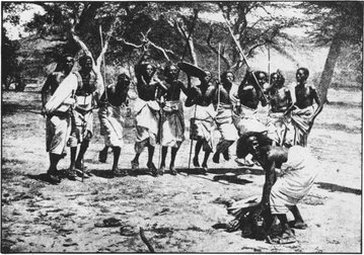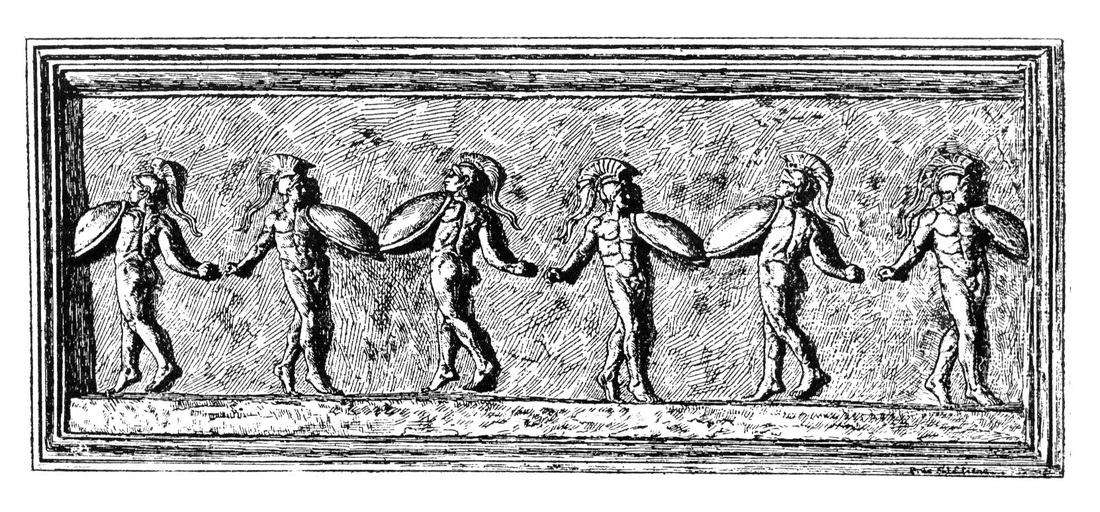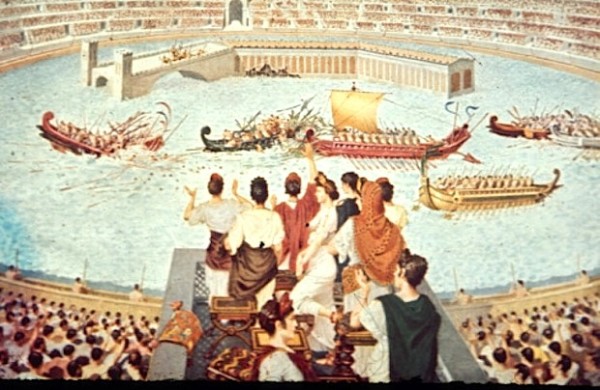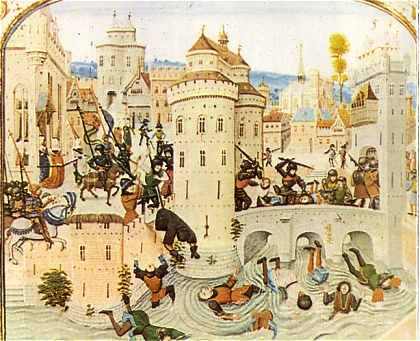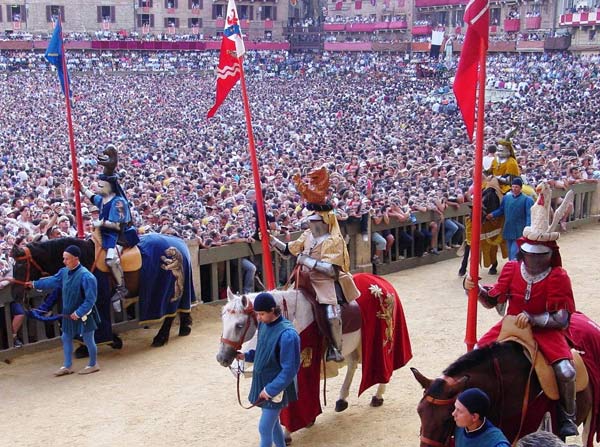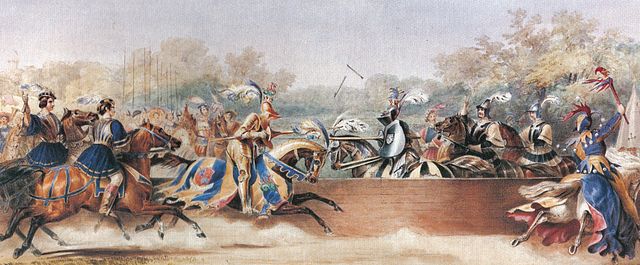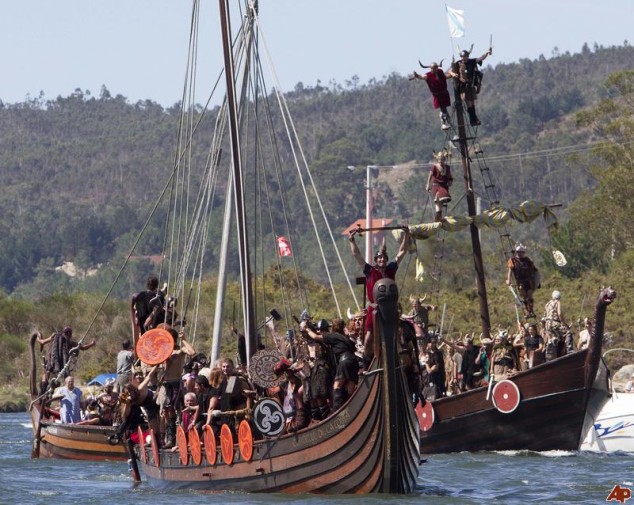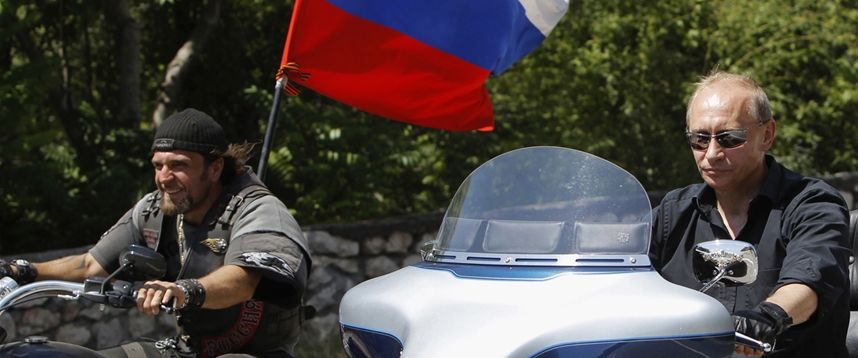HISTORY OF REENACTMENT
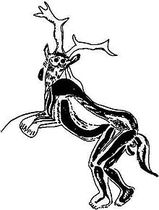
'SCORCEROR' :Trois-Freres cave, Ariege, France.
13000b.c.
It is easy to imagine that reenactment events are a modern phenomenon, something that members of post-modern consumerist society uses to distract itself or create meaning while avoiding their existential angst.
In fact, reenactment and reenactment fighting are fundamental and universal aspect of human culture. What we do in the 'viking', 'medieval' etc. reenactment worlds is only our immediate version of a tendency in all societies at all times. It is absolutely nothing new. It is absolutely a basic human social activity.
Reenactment in its simplest form is a form of magic. Hunter-gatherer cultures perform dances to influence their luck in the chase. Dancers show how they were successful last time, how the prey tried to escape but how the skill of the hunters prevailed. The dancers may be dressed as animals and hunters in skins and carrying weapons. Reenactment is also part of dances which exhibit the origin stories and myths of simple peoples. Dancers play the parts of gods, heroes and animals, usually costumed and sometimes even drugged. The dancers may enter trances and communicate messages from the supernatural or gain insight into the future.
In fact, reenactment and reenactment fighting are fundamental and universal aspect of human culture. What we do in the 'viking', 'medieval' etc. reenactment worlds is only our immediate version of a tendency in all societies at all times. It is absolutely nothing new. It is absolutely a basic human social activity.
Reenactment in its simplest form is a form of magic. Hunter-gatherer cultures perform dances to influence their luck in the chase. Dancers show how they were successful last time, how the prey tried to escape but how the skill of the hunters prevailed. The dancers may be dressed as animals and hunters in skins and carrying weapons. Reenactment is also part of dances which exhibit the origin stories and myths of simple peoples. Dancers play the parts of gods, heroes and animals, usually costumed and sometimes even drugged. The dancers may enter trances and communicate messages from the supernatural or gain insight into the future.
|
The other social activity which has rather anti-social results is warfare. The outcomes of warfare are even more immediately crucial than hunting and so it comes as little surprise that reenactment becomes part of the preparation. War dances mimic what happens in warfare, what happened in previous successful ventures and what is hoped will happen in the impending one.
|
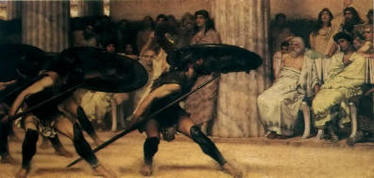
Once societies become settled and form more fixed identities war dances and reenactment remain important. They become closely related to formalised religious practices that become very important for continuity and group identity.
From 668b.c. the Spartans held a summertime festival called the Gymnopedia. Here young warriors danced naked with weapons to reenact a defeat in battle in order to appease the gods and to avoid repetition of that failure. It is not incidental that the dancing itself gives strenuous exercise to the warriors who mimic movements of combat.
There were war dances spread more widely throughout the Greek states. At the time of Herodotus, Plato and Aristotle when we tend to think of logic and rationality as the dominant mindset the warriors of the Greek states were performing war dances. These war dances were initially performed by a specific caste, the korybantes, but later locals participated. This dance was also known as the Phyrric dance or kouretic dance. The dancers wore crested helmets, wore armour and bore arms. They stamped their feet and clashed their arms in time to a drum. In some sense it was also a coming-of-age ritual and formed part of the military class's education. Dance will reappear as a part of our story later.
From 668b.c. the Spartans held a summertime festival called the Gymnopedia. Here young warriors danced naked with weapons to reenact a defeat in battle in order to appease the gods and to avoid repetition of that failure. It is not incidental that the dancing itself gives strenuous exercise to the warriors who mimic movements of combat.
There were war dances spread more widely throughout the Greek states. At the time of Herodotus, Plato and Aristotle when we tend to think of logic and rationality as the dominant mindset the warriors of the Greek states were performing war dances. These war dances were initially performed by a specific caste, the korybantes, but later locals participated. This dance was also known as the Phyrric dance or kouretic dance. The dancers wore crested helmets, wore armour and bore arms. They stamped their feet and clashed their arms in time to a drum. In some sense it was also a coming-of-age ritual and formed part of the military class's education. Dance will reappear as a part of our story later.
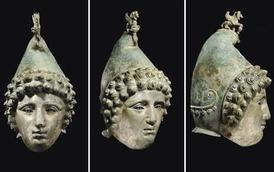
Roman cavalry parade helmet in form of an Amazon warrior.
The Roman Empire is remarkable in that despite its strong military traditions, innovations and strength over seven centuries we have limited information about military training or
technique from original sources. Vegetius' manual is an exception.
But reenactment figures in even this limited evidence. Some of the most beautiful examples of the armourers art we have surviving from the classical world are types of cavalry helmet which completely enclose the head and have realistic face-masks and hair.
These helmets were used in cavalry exercises that reenacted combat between Greeks and Amazons from the mythic past.
Again, the reenactment was a pretext for exercise and practice of horsemanship and combat abilities.
technique from original sources. Vegetius' manual is an exception.
But reenactment figures in even this limited evidence. Some of the most beautiful examples of the armourers art we have surviving from the classical world are types of cavalry helmet which completely enclose the head and have realistic face-masks and hair.
These helmets were used in cavalry exercises that reenacted combat between Greeks and Amazons from the mythic past.
Again, the reenactment was a pretext for exercise and practice of horsemanship and combat abilities.
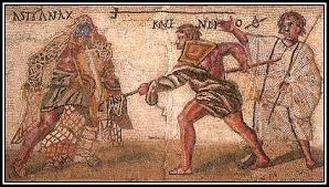
In the early Roman empire the gruesome spectacle of gladiatorial games were arranged as reenactments. The gladiators were styled after Rome's defeated enemies and the reenactment of their downfall had a moral purpose. The largest form of gladiatorial display was the naval battle staged in a flooded arena or a purpose-made basin.
Two fleets clashed in imitation of ancient protagonists and the participants were numbered in thousands. Julius Caesar staged a 'naumachia' between Egyptians and Tyrians that involved 6,000 combatants. Augustus later staged a version of the battle of Salamis between Athenians and Persians where 3,000 men and 30 vessels clashed. Domitian trumped both these by setting 19,000 men and 50 full size ships to war in his naval 'reenactment'.
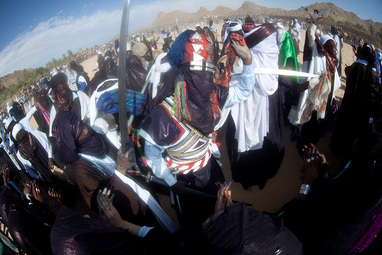
Tuareg sword dance, Algeria. Blades handled carelessly for show.
The enemies of Rome were studied by their conquerors, though often just so they could be used as examples of the noble savage that might be contrasted with the degeneration of the civilized world. Gauls were the bane of the Roman Republic but the people who halted the Roman empire's expansion were the Germanic tribes.
They were admired and feared and in his work 'Germania' the historian Tacitus gives us a glimpse of what seems very like a war dance as practised by agricultural pastoralist warriors the world over. Young men danced naked around sharp weapons and impressed the audience with their agility and courage.
They were admired and feared and in his work 'Germania' the historian Tacitus gives us a glimpse of what seems very like a war dance as practised by agricultural pastoralist warriors the world over. Young men danced naked around sharp weapons and impressed the audience with their agility and courage.
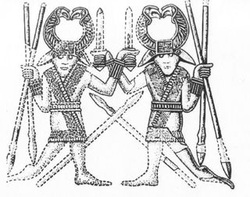
'Dancing warriors' from Sutton Hoo helmet. 6thcen.a.d.
These armed dances figure in later Germanic archaeology where there are illustrations of apparently dancing warriors bearing spears. We have also many figurines from the Bronze Age which, although unarmed show gymnastic poses. There seems to have been a tradition in northern Europe, as there is world-over, of warriors dancing with weapons right down to the eigth century if not later.
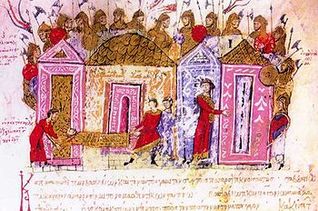
Varangians from Skylitzis manuscript. Not in dancing mood here...
In the later Roman empire we have the mysterious Gothic dance of the emperor's bodyguard. This is a perpetuation of their own customs which was practised by the Germanic warriors who formed senior bodyguard units. The dance was performed at or near Christmas which was the Germanic Yule festival and involved circle dancing with specific clothes and music and maybe animal masks.
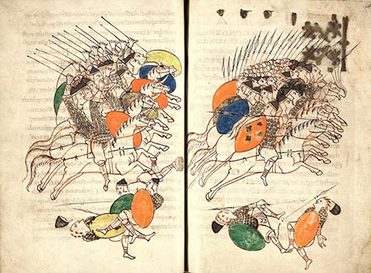
Illustration from St.Gall Maccabees. Cavalry in pursuit as described by Nithard.
Later in time we have a description of how the Frankish kings exercised their warriors, at least the noble warriors who fough tas cavalry. When the warriors assembled they played games which very much resemble the Greeks and Amazons exercises of the Roman cavalry. (Nithard Book 3, VI). This is mock warfare carried out in peacetime and with the intention of showing and honing skills without injury.
"For exercise they arranged frequent games in the following way. People would get together in a place suitable for a show and with the whole crowd standing on either side, Saxons, Gascons, Austrasians and Bretons in teams of equal numbers first rushed forth from both sides and raced together at full speed against each other as if they were going to attack. Then one side would turn back, pretending they wished to escape from their pursuers to their companions under the protection of their shields. But then they would turn round again and try to pursue those from whom they had been fleeing until finally both kings and all the young men with immense clamour rushed forward, swinging their lances and spurring their horses, pursuing by turns whoever took flight. It was a show worth seeing because of its excellent execution and discipline; no one in such a large crowd and among such different peoples dared hurt or abuse another, as often happens when the opponents are few and familiar to each other."
When we pass into the true age of the knight, whose predecessors the Frankish cavalry were, then we come across that epitome of peacetime combat, the tourney. The tournament was a form of war in peacetime which allowed the warrior class to keep their hand in. It became more and more stylised and further and further away from real warfare but that is what it was based upon.
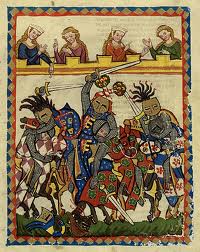
As well as the tourney proper there were festivals and events which focussed on mock fighting which aped real wars or legendary wars of the past. As early as 1180 William Fitzstephen gives us an account of the youths of London engaging in wargames outside the city walls :
19. War games in the fields
Every Sunday in Lent, after lunch, a "fresh swarm of young gentles" goes out into the fields on chargers and "steeds skilled in the contest", each being "apt and schooled to wheel in circles round". Crowds of the lay sons of citizens pour through the city gates armed with military spears and shields; the younger carry spears whose metal point has been removed. "They wake war's semblance" and practise military exercises. With a view to joining in the combats, there come many of the king's entourage, when he is in residence; and from the households of earls and barons, young men not yet invested with knighthood. Each is consumed by a hope for a victory. The fierce horses whinny, "their limbs tremble; they champ the bit; impatient of delay they cannot stand still". When finally "the hoof of trampling steed careers along", the young horsemen have divided themselves into troops; some unhorse their comrades and speed past, while others chase those who retreat, but fail to catch them.
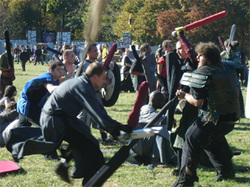
To give just one more medieval example from many, many I would mention the mock battles of Venice described by Caravia from 1421. In these the combatants were specially armed with helmet and stick rather than steel weapons.
La Verra Antiga – The Ancient War : The Celebration of the 1421 Mock-Battle at Servi
Bridge in Venice from Allesandro Caravia’s mock-heroic poem
In one thousand, four hundred and twenty one
In the day of Sail-ripper San Simon
Everyone meet at Servi (bridge)
With his stick and helmet
To show off who is white or brown
And that no one is a simpleton
Displaying to be skilful one better than the other
and not to be afraid of stick blows
The carnival season each year brought revelry and chaos to europe's cities and reenactment of mythological themes or historical events, often to make political satire, were part of this. Ultimately formalised into the sword dances and Morris dances that are common across Europe the armed dances and revels were a rite of passage for young men and a militaristic expression possible in peacetime under domineering overlords.
La Corsa dei Palio, Sienna's famous bareback horserace was actually introduced to replace bloody gang fighting and in that sense is a reenactment of ancient contests. The Renaissance also spawned the concept of the Masque and many were performed with ancient or medieval wars as their themes. In Galicia the Tatars are the enemy and mock fighting in pantomime horses is performed at Christmas.
La Verra Antiga – The Ancient War : The Celebration of the 1421 Mock-Battle at Servi
Bridge in Venice from Allesandro Caravia’s mock-heroic poem
In one thousand, four hundred and twenty one
In the day of Sail-ripper San Simon
Everyone meet at Servi (bridge)
With his stick and helmet
To show off who is white or brown
And that no one is a simpleton
Displaying to be skilful one better than the other
and not to be afraid of stick blows
The carnival season each year brought revelry and chaos to europe's cities and reenactment of mythological themes or historical events, often to make political satire, were part of this. Ultimately formalised into the sword dances and Morris dances that are common across Europe the armed dances and revels were a rite of passage for young men and a militaristic expression possible in peacetime under domineering overlords.
La Corsa dei Palio, Sienna's famous bareback horserace was actually introduced to replace bloody gang fighting and in that sense is a reenactment of ancient contests. The Renaissance also spawned the concept of the Masque and many were performed with ancient or medieval wars as their themes. In Galicia the Tatars are the enemy and mock fighting in pantomime horses is performed at Christmas.
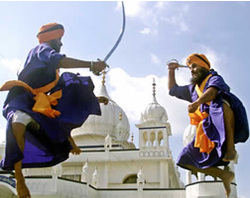
Sikh gatka fighters
In the east mock battle and reenactment was also practised. In the Sikh stories of Guru Gobind Singh Ji it is described how Prince Gobind Ri taught himself and others how to fight in mock battles. To this day the festival of Holla Mohalla includes three days of mock battles which recall the tenth century founding of the Sikh armed forces. It can be said that the crux of this holy festival is reenactment fighting and display.
The Eglington tournament of 1835 is the best documented reenactment of the modern age prior to modern media and ranks with what we would nowadays refer to as a reeenactment battle. It was a tournament arranged with great attention to authentic historical detail and became the world's first mass tourist event served by rail transport.
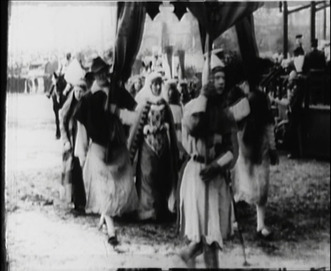
Parade at Liverpool's 1907 700th anniversary pageant.
In the Age of Industry migration and massed housing destroyed many folk practices but galas, festivals and parades persisted. In many British towns and villages 'cavalcades' showing histroical scenes and famous people were often shown. In Liverpool in 1907 the seven hundredth anniversary of the city's royal charter was celebrated in style. The parade and fair included a viking ship and the earliest film of mock combat was taken at the event by the Lumiere brothers where the Stanleys and the Molyneuxs knock seven bells out of each other.In the 1900s the development of cinema prompted mass battle reconstructions such as The Siege of Sevastopol in Russia and D.W. Griffith's Birth of a Nation in the USA which, while not really reenactments in the modern sense must have done alot to create the potential for the concept. The Great Reunion at Gettysburg in 1903 also stimulated interest in remembering even the living past but it was not itself a reenactment.
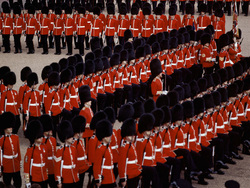
Even today in the U.K. we have an annual reenactment of Napoleonic military drill in the ceremony of Trooping the Colour. The uniforms and drill have long since passed from practical use but wheeling and turning in serried
ranks is still carried out to the delight of the the public and as identity reinforcement for the unit involved.
ranks is still carried out to the delight of the the public and as identity reinforcement for the unit involved.
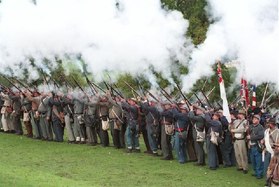
After the Second World War the modern age of reenactment was begun. In the USA the centennial of their civil war gave a great boost with many events being held and societies being created. American Civil War reenactment is probably the widest practiced and most numerous branch of the modern hobbywith possibly 60,000 adherants.The SCA, not strictly a reenactment society , maybe, but with a massive and worldwide membership should not be dismissed lightly.
In the UK Brigadier Peter Young and his associates started the Sealed Knot in 1968. This society has thousands of members today and recreates the battles of the English Civil War.
Started by, and supervised by ex-military people these societies spawned many others and can probably take the credit for all modern hobby reenactment societies existence.
In the UK Brigadier Peter Young and his associates started the Sealed Knot in 1968. This society has thousands of members today and recreates the battles of the English Civil War.
Started by, and supervised by ex-military people these societies spawned many others and can probably take the credit for all modern hobby reenactment societies existence.
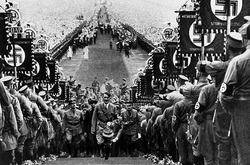
What the modern reenactors have done is to show that the reenactment could be totally divorced from tradition, religion and nationalism (almost totally, that is) and be enjoyed for its spectacle and engagement. The emotional and intellectual stimulation that nationalism curried and subverted with the use of pseudo-historical rallies and parades has, ironically, now become a force for internationalism, celebration of common historical links and best of all, as a source of fellowship and fun for people the world over.
POSTSCRIPT
Sadly, since I first put this piece up , re-enactment has figured in a real conflict. For the first time since the Second World War a European country has been invaded. Russia has annexed the Crimea from Ukraine and is actively supporting separatists in the Donbas. One of the criminals who started this war - and is especially proud of starting the shooting - GRU agent Igor Girkin ( who also uses the more glamorous name 'Strelkov', has used reenactment as part of his means to promoting his cause and recruiting. Reenactment events in Russia have also been rebranded as 'Patriotic Events' and play into the hands of Putin's new narrative for the Post-Soviet land. It is the responsibility of individual reenactors to determine if their activities create a hippy summer camp, a breeding ground for fascists or an enjoyable attempt to give a glimpse of a passed age.
Sadly, since I first put this piece up , re-enactment has figured in a real conflict. For the first time since the Second World War a European country has been invaded. Russia has annexed the Crimea from Ukraine and is actively supporting separatists in the Donbas. One of the criminals who started this war - and is especially proud of starting the shooting - GRU agent Igor Girkin ( who also uses the more glamorous name 'Strelkov', has used reenactment as part of his means to promoting his cause and recruiting. Reenactment events in Russia have also been rebranded as 'Patriotic Events' and play into the hands of Putin's new narrative for the Post-Soviet land. It is the responsibility of individual reenactors to determine if their activities create a hippy summer camp, a breeding ground for fascists or an enjoyable attempt to give a glimpse of a passed age.
